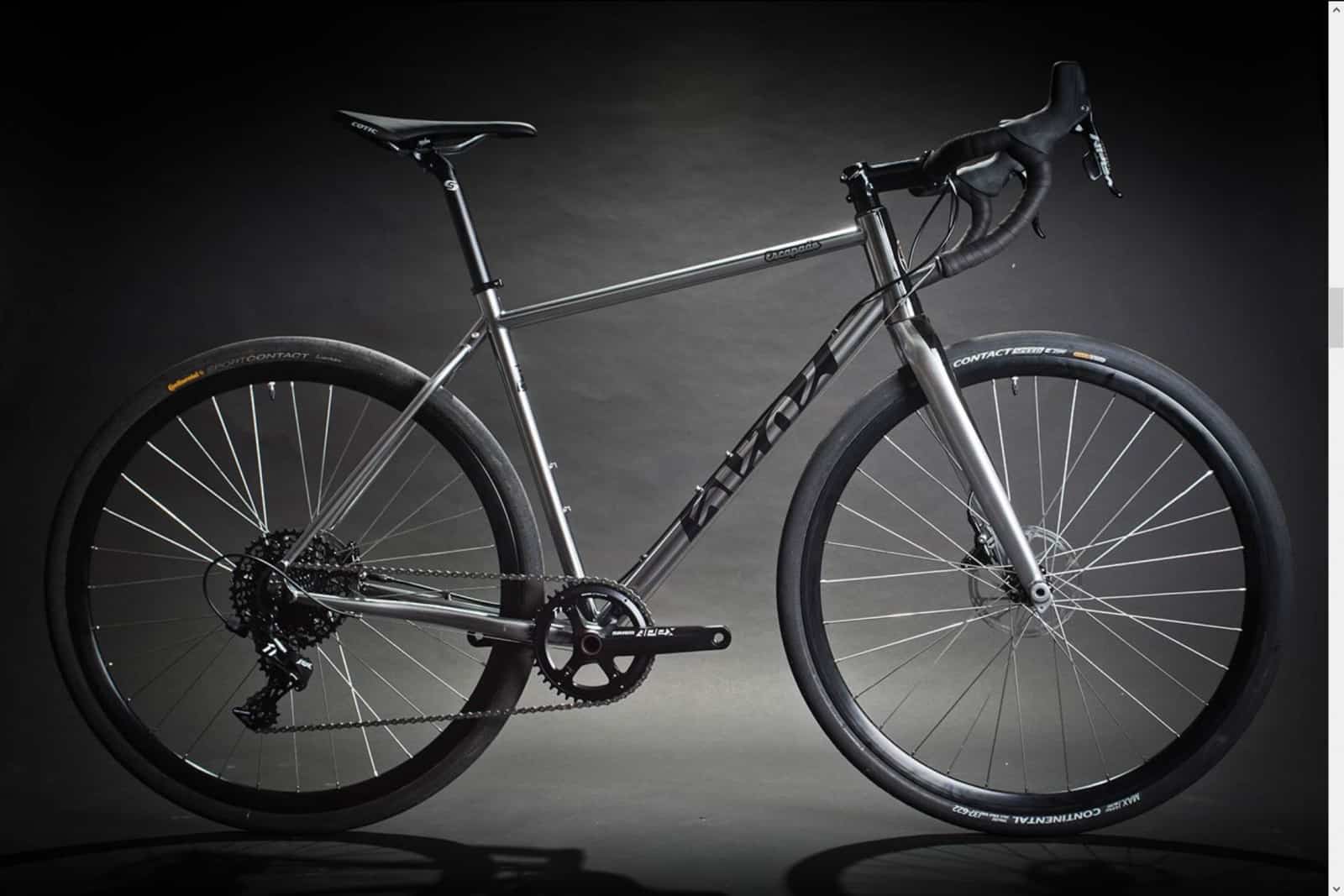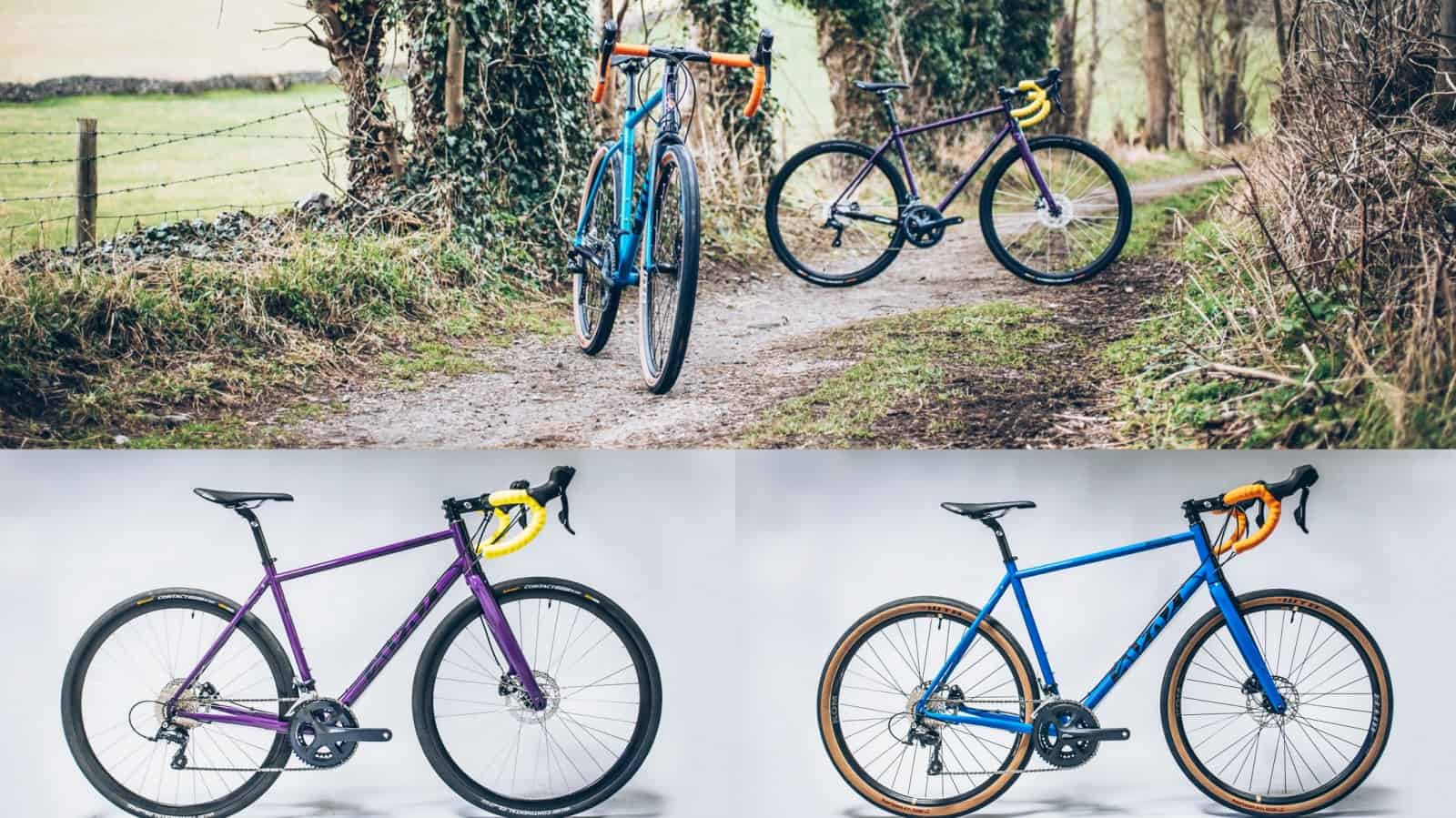After interviews with titanium and carbon bike makers, it is time to talk more about steel bikes. I own a steel bike and love the comfort and ‘springy’ feel of it. But is steel still relevant in an era of advanced carbon and titanium frames? To find out I talked to Cy Turner, the founder of Cotic Bikes.
CyclingAbout: Can you introduce yourself to the readers?
Cy: My name is Cy Turner. I am the Founder and owner of Cotic Bikes. I run the business and design all the frames, amongst other things.
CyclingAbout: What was the idea behind the Cotic brand?
Cy: I founded the company because I was moving back into riding hardtails after I came out of DH racing in 2001, but I couldn’t find anything with good geometry to take the shorter stems and wide bars I was used to on my DH bike. And I wanted big tyres with lots of clearance and front and rear disc brakes, again like my DH bike. I always loved steel for hardtails, much more than any other material. The way it feels and breathes with the trail because of the compliance cannot be matched. Back then steel was considered really old-fashioned and anything steel-framed was really retro with bad geometry and no clearance. The closest I got was buying a 99 Kona Caldera in steel and putting a 90mm stem, 100mm Psylo forks, and high-rise 680mm bars on it. These were considered short, long, and wide back then! It still didn’t have clearance for a 2.3 tyre or a rear disc brake though, and the geometry wasn’t great with the 100mm fork, and it was too short. I measured it up and redesigned a frame around all the things I wanted. I wanted a progressive steel hardtail. I still do! I’m a Mechanical Engineer by training, so designing solutions is what I do. I love 853 material as it’s so strong and durable. I was going to get one custom-made, but a chance introduction led to an offer of make 100. I didn’t have to give up my job to start the company, and my friends could help with the website and graphics, and everyone who rode them loved the prototypes, so I got a big loan and started a bike company. There was no more plan than that. Get a cool bike I wanted, maybe sell some to fund my biking. That was in 2003. You can see our history in our 15 years video if you have a few minutes.
CyclingAbout: Why steel bikes? What is so special about steel in your opinion and does steel still has a place on the gravel market today when there are so many carbon gravel bikes promising a lot of compliance but at the same time the stiffness and lightness?
Cy: I use steel for performance. Regardless of how much people say they can tune a carbon bike, you still can’t beat steel for that ability to mold to the terrain and ‘give and go’ through a camber or root section. This is unbelievably important in an off-road bike. I also think people obsess way too much over the weight of their bikes and frames in particular. If a steel frame weighs a few hundred grams more than a carbon frame, overall I think it’s way less important than the ride feel, toughness, and durability of steel as a material. If you weigh 80kg, and your bike weighs 10kg in steel or 9.5kg with carbon, you have saved less than 0.6% off the total mass of the system. People get into it because they like buying things and it’s an easy thing to measure and state as ‘better’, I understand that, but it’s much more nuanced I believe. And following on from toughness and durability, steel is so much more sustainable than carbon. Carbon fibre frames are made out of plastic. They are virtually impossible to recycle, and they don’t have a great lifespan, so they get old and if they don’t get damaged or broken, they go into landfills or incinerators. Steel is low impact, by comparison, can be recycled many times, and have a very long life span. This is so important.
CyclingAbout: I recently have spoken with a steel frame builder who said that carbon can flex so it is beneficial to make thin seat stays etc but steel will never flex in a similar way so there is no point in making flexing stays or something like that and the main contributor to the comfort of a steel frame is the steel itself that absorbs vibrations effectively. Do you agree with that statement?
Cy: Yes, I agree with the frame builder. The rear triangle of a frame is incredibly stiff because it’s a small triangle. Frame flex in terms of ride feel and grip comes from flex along the length of the frame in torsion and some bending in the side view. This is broadly controlled by the top tube size and shape, hence our Ovalform technique for this tube.
Ride comfort on a steel frame comes from the whole frame ‘buzzing’ less, I agree with that, but also because steel frames often use 27.2mm seatposts and small seat tubes, which allow a lot more deflection than almost any frame-related flex. Intrinsically steel is a spring. Of course, I am hypothesizing here because I haven’t designed a carbon frame before, but I think the difference people feel is the flex and feel of a steel frame coming much more from the front triangle so the whole bike feels like it’s helping to work with the ground it’s moving over, whereas on a carbon frame which is very flexible vertically at the rear, but I suspect very stiff at the front triangle, doesn’t have that same movement along the whole frame. It’s very much discreet: one area is stiff, and one area is flexible. Steel frames move all of a piece along their length, maybe feeling more homogenous as a result. I’m just hand-waving on that really.

Cy: We have made titanium hardtails. It’s a beautiful material. I don’t really know with respect to road/gravel bikes, but I expect you can build something with a very nice steel-like ride feel, but very much lighter. With mountain bikes, you end up needing to use quite big sections in titanium to get the strength and stiffness required to give a good feel and performance off-road, which means some of the ride feel is lost, but it’s definitely still lighter. And shinier. We mustn’t forget how shiny it is! But I should also point out another key advantage to titanium and steel over carbon and aluminum – toughness in terms of rock striking the down tube. It’s an issue on mountain bikes where the carbon is really quite thick, but on gravel bikes, a thin carbon down tube must have questionable longevity in that rock-strike environment.
CyclingAbout: The single most unique feature of your Escapade bike is the mono seat stay (at the cross-section with the seat tube). Why did you go with that design and what are the benefits of it? Does it offer more or less compliance than a traditional seat stay design?
Cy: The wishbone is a signature Cotic look, but it’s nothing to do with the compliance, I just love how it looks. Compliance doesn’t really come from the seat stays, that’s a myth. The rear triangle is so compact it really is rigid. You use smaller seat stays where you can save weight, but it makes virtually no difference to the ride. The way the front triangle tubing is specified is way more important, such as seatpost size, extension, and diameter.
CyclingAbout: The cross-section between the mono seat stay and the seat tube is unusually high (above the level of top tube). Why is that? And why we don’t see any steel bikes with the seat stay connected with the seat tube somewhere in the middle of the seat tube (like many gravel bikes have these days)?
Cy: It’s there for durability, to support the lightweight seat tube and compact frame design which requires a fairly large seatpost extension. It keeps the classic lines of the frame, which I like, and it’s also easier to mount more different styles of rack when the seat stay is there. I don’t understand the whole low-seat stay junction at all. It’s incredibly inefficient from a structural design point of view. The load path is horrendous! It’s almost certainly just fashion. I guess it’s from aero road bikes where they are willing to compromise the structure for lower drag.
CyclingAbout: Your bike has a rather short chainstay (425mm). This makes the bike more agile and fun but how this affects the comfort (compliance) of the frame? The reason I am asking is that I think the longer the chainstay the more flex they will offer.
Cy: The chainstay length is what it is to get the clearance we need, whilst keeping it fairly short to keep the weight balance nice. Longer chainstays push the weight forward onto the front wheel, which isn’t ideal on a very short front centre bike used off-road. Short front centre compared to a modern MTB I mean. The Escapade isn’t a full gravel bike either. Gravel kind of happened around it. It was conceived as a tough, versatile disc drop-bar bike, and it first appeared 6 years ago. Lots of our customers ride them almost exclusively on the road, with all the benefits of comfortable, grippy big tires, and engaging handling because the wheelbase isn’t super long. As for compliance, see my answer above. It doesn’t make any difference vertically. The only stiffness change/loss you get with longer stays is lateral, which is to do with pedaling power transfer and that ‘give’ along the length of the bike for traction. So, it can help to have longer stays for traction, but you often need a bigger or thicker tube on longer stays to keep the power transfer reasonable.
CyclingAbout: I have a Jamis Renegade Exploit steel bike. It is a very comfortable bike but at the same time not a very power-efficient one (especially compared to carbon bikes, that at the same time, start to rival my steel Jamis in terms of comfort and compliance). What did you do to your Escapade bike / what in general can be done to a steel bike to make it stiffer where it needs to be stiff so it can accelerate quickly?
Cy: Being stiff for accelerating quickly isn’t something I consider. It needs to be efficient enough, but it’s not a race bike. It’s more important to me for it to have that ride feel I want than to be the quickest out of the gate. However, the usual things can be done, should you so wish: Larger diameter seat tube, down tube, and seat stays give a more torsionally stiff ‘spine’ to the frame, but it’s at the expense of compliance in the direction that I think it’s important.
CyclingAbout: Do you like the T47 bottom bracket standard? Do you see it as a way of improving the power transfer efficacy of a steel bike?
Cy: Not particularly. It makes seat stay design and bends for tire clearance harder because it’s effectively closer to the tire for a given chainstay length, and this is one of the hardest parts of the frame to package. It’s heavy, and it’s not especially difficult to use a regular 38-39mm BB to build with the biggest tubes you would sensibly use in steel. 42 or 44mm tubes are the biggest Columbus make, but with a flat oval at the BB (which is good for power transfer anyway), you can miter on centre to a small BB shell to keep the joint easy to make.
CyclingAbout: A lot of titanium but also steel bikes uses a plate in chainstay to allow for bigger tire clearance. Do you like that trend or do you prefer to use a dropped chainstay design? And what is the impact in terms of compliance when you use a plate in chainstay?
Cy: I don’t like either! Plates are heavy and very flexy laterally, too much in my opinion. It’s an easier solution in some ways, but they have fatigue issues due to the rate of change of stiffness in a short space. Dropped chainstay looks completely awful. I have no idea how they affect compliance because I haven’t looked at them for a technical solution. Steel stays are pretty narrow, so I haven’t yet found a situation where I couldn’t find a good compromise in terms of chainstay length versus tire clearance. Other things are happening to help too. GRX, for example, has a +3mm chain line compared to the road, which is really helpful if you can exploit it.
CyclingAbout: From what I have learned moving the axle forward (bending the fork forward) or backward (like in my Jamis ECO fork) increases the flex and thus the compliance but your fork does not use any of those solutions so what did you do to make the fork of Escapade more compliant?
Cy: The Escapade fork isn’t to our design. We’re not big enough to tool up for a carbon fork ourselves. The fork was chosen after riding a bunch of different options, and it had the best blend of compliance and precision. Moving to the RB5 carbon fork from our own design RB3 steel fork, the feedback from customers was they wanted more precision and more compliance. The RB5 provided that. Steel in forks is one area where I struggle to get the blend of ride feel, strength, and stiffness under braking to a really good compromise. The RB2 was very compliant with a very tapered leg, but it moved a lot under braking which isn’t very confidence-inspiring. The balance of compromise on a fork should be for confident handling and braking, I believe.
CyclingAbout: 700c or 650b with your bike? What wheels you are using? And what tire pressure when using a 700×43 mm tire and 650bx50 mm tire (both setup tubeless) on an Escapade bike?
Cy: I prefer my Escapade with 650b tires. I run the WTB Horizon or Byway 47mm wide tires at 35 psi front and 40 psi rear. I did the maths on the spring rate of a 700×25 tire at 100psi, and then worked back to the same spring rate with the 650×47 big volume setup and 35psi is the same rate. I’m 85kg for reference. They just float along rough tarmac so nicely. I don’t use them a massive amount off-road as I tend to switch straight to my mountain bike if I’m going to be on the trails. I haven’t run 700×43 tubeless, so I can’t give you an answer there.
CyclingAbout: What do you think about the solutions like BMC MTT, Cannondale Kingpin suspension, or Specialized Future Shock? In other words, can a steel frame without any moving parts?
Cy: They’re interesting, but there’s nothing new under the sun. Mountain bike soft tails in steel using this idea was around for years in the 90s. It’s possible to build a steel frame to do this, but there’s always a durability compromise introduced when adding significant flex to a structure. And ultimately this kind of thing is about rider comfort, not wheel control and grip like the proper suspension is. If you’re talking rider comfort I don’t think you can beat a Cane Creek Thudbuster or eeSilk. I have an eeSilk on my Escapade and it’s fantastic.
CyclingAbout: What do you think about the trend of flexing handlebars like Giant D-Fuse or a carbon HollowGram from Cannondale (which is a very flat handlebar with a lot of visible flex)? Do you intend to offer similar solutions to your gravel bikes?
Cy: It’s not something we’re actively looking into, but if one of our customers wanted to fit these style bars they could. We assemble every single bike to order: Your Bike Built For You. So, if there’s something you can’t see on our configurator, or you have a fixed idea about a part you want to send to us to include in your bike build, we can do that. Super easy. We did it just last week – a customer bought an Escapade Platinum build which is GRX 800 1x, but he wanted 2x and had a flex stem and his own seatpost, so we special ordered the 2x drivetrain and put his stem and seatpost on his bike as part of the build.
CyclingAbout: What gravel trends in general and in terms of comfort do you see emerging or getting stronger in the coming years?
Cy: I think the market will stratify a little more. I think we’re at the limit of what is a sensible compromise with the current Escapade in terms of some light off-road capability whilst maintaining engaging and fun handling for more on-road rides. For people wanting more off-road capability, the so-called Adventure genre of more like drop bar mountain bikes seems to be a more sensible option. If you ride more off-road, then having better equipment for that seems sensible.
CyclingAbout: Thank you very much, Cy, you were very informative!
Cy: Great! Thank you for this opportunity.









